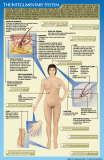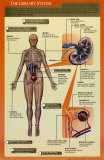|
|
Body Systems Educational Posters & Charts
for the science classroom, home schoolers, physicians and health professionals offices.
|
science > biology > anatomy > BODY SYSTEMS < health posters
|
|
Body Systems : circulatory, digestive, endocrine, integumentary, lymphatic, musculoskeletal, nervous, reproductive, respiratory, urinary.
|
|
Integumentary System
Poster Text: The integumentary system consists of your skin, hair and nails. As your body's outer covering, it helps maintain fluid balance by keeping interior fluids in and exterior fluids out. It also produces melanin pigment that protects against excessive exposure to ultraviolet rays. The skin excretes water and other substances through sweat glands and sebaceous glands. Sweating helps control your body temperature and sebaceous glands produce sebum to keep your hair soft, so it doesn't break off. In addition, the skin produces vitamin D (with help from the sun's ultraviolet rays), which is crucial to keep your bones healthy. Finally, the integumentary system communicates with the nervous system to send messages about what's going on in the exterior environment, such as heat and cold, touch, pressure, and pain. ...
• skin / touch posters
|
|
|
|
Urinary System
Poster Text: The urinary system is responsible for filtering waste from the blood and removing it from the body. To begin the process, the renal arteries transport blood into the kidneys. These arteries contain small branches at their ends that allow them to enter the nephrons, which remove harmful substances from the blood. As the kidneys clean the blood, liquid water - known as urine - is produced. Once the kidneys have filtered the blood, the urine passes through the ureters to the bladder. Here the urine is stored until it is expelled from the body. ...
|
|
|

Circulatory System Laminated Poster
sorry, not available
|
Circulatory System
Poster Text: Your circulatory systems primary responsibility is to circulate blood throughout your body, delivering nutrients and oxygen to and removing waste from your tissues. Your blood also carries hormones and other regulatory molecules to various organs and glands. The cirulatory system protects against injury and disease through clotting and microbe destroying white blood cells. This system is itself made up of three smaller systems, each of which is responsible for circulating blood to a different part of the body. First is the systemic system, which transports blood to and from the tissues of the body. Next is the pulmonary system, which circulates blood between the heart and the lungs. Last is the coronary system which provides nutrients to the heart itself.
• circulatory posters
|
|
|

Digestive System Laminated Poster
sorry, not available
|
Digestive System
Poster Text: The digestive system is responsible for taking in the food we ear and converting it in to nutrients that the body uses to sustain itself. The digestive system performs two functions: breaking down food into small molecules, and absorbing these molecules into the body. These process allow the nutrients from the food to enter your blood system in order to be distributed throughout your body. These nutrients are used to produce energy and a building blocks for growth and repairing tissues. ...
• digestive posters
|
|
|

Endocrine System Laminated Poster
sorry, not available
|
Endocrine System
Poster Text: The endocrine system is responsible for controlling the functions of the body by producing and secreting hormones. Hormones, which come from a collection of glands, impact almost every cell in the body and function to keep the body in balance - a complicated process known as homeostasis. The endocrine system used feedback mechanisms to regulate hormones and maintain homeostasis. Negative feedback occurs when changes in the body cause a response that returns a system to its original state. Negative feedback mechanisms are primarily responsible for maintaining homeostasis. Positive feedback causes a system to continue to respond to an environmental change.
ANTERIOR LOBE: Secretes hormones responsible for growth, milk production in females, and other hormones that stimulate the thyroid gland and sex organs.
PINEAL GLAND: Regulates the wake-sleep cycle.
POSTERIOR LOBE: Secretes hormones for controlling the amount of water reabsorbed by the kidneys as well as hormones that stimulate the uterus to contract and mammary glands to release milk after childbirth.
PITUITARY GLAND: Makes hormones that control several other endocrine glands.
THYMUS GLAND: Secretes hormones that regulate the immune system.
HYPOTHALAMUS: Area of the brain that serves as the primary link between the endocrine and nervous systems.
PANCREAS: Produces hormones to help regulate metabolism.
THYROID: Produces hormones to control the rate at which the body burns food.
THYROID GLAND: Releases hormones that regulate metabolism.
PARATHRYROID GLANDS: Four tiny glands that function as one to regulate the level of calcium in the blood.
ISTHMUS: Tissue that connects the to lobes of the thyroid.
ADRENAL GLANDS: Regulate many functions such as stress and heart rate.
REPRODUCTIVE GLANDS: Secrete hormones such as estrogen and testosterone that regulate the reproductive system.
• endocrine / lymphatic system posters
|
|
|

Lymphatic System Laminated Poster
sorry, not available
|
Lymphatic System
Poster Text: The lymphatic system has three primary functions: fighting disease, transporting interstitial fluid back to the bloodstream and absorbing lipids from the digestive tract. Fighting Disease: When a virus or bacteria attacks your body, your lymphatic system works in several ways to protect your lymph nodes produce more B-cells and T-cells. T-cells attack germs (called antigens), and B-cells make antibodies to protect the body from the antigen in the future. Transporting Interstitial Fluid: Lymph seeps outside the blood vessels into body tissues to carry food to the cells and remove waste products from the tissues and carry them back to the bloodstream. Lymph then drains into the lymphatic vessels, where it is filtered by the lymph nodes and returned to the bloodstream. Absorbing Lipids: The lymphatic system serves as the route by which absorbed fat from the intestine is transported to the blood. ...
• endocrine / lymphatic system posters
|
|
|

Musculoskeletal System Laminated Poster
sorry, not available
|
Musculoskeletal System
Poster Text: The skeleton is your body's superstructure. This intricate network of bones support the body and protects soft tissue and internal organs (such as the brain, heart, and lungs). The various points in your skeletal system make it possible for you to move in a variety of ways. Your bones also produce blood cells and stone essential minerals, including calcium. Muscles work in tandem with bones to enable you to move your body, stand upright, digest food, and remove waste from your body. They are also an important source of heat for your body. Tendons connect muscles to bones, and transfer the force of contraction from the muscle to the bone that is to be moved. ...
• muscular system posters
• skeletal system posters
|
|
|

Nervous System Laminated Poster
sorry, not available
|
Nervous System
Poster Text: The nervous system sends and receives sensory and motor messages throughout your body, bringing in information from the outside world and controlling all your activities. Sensory impulses are messages taken in by the body that inform the nervous system about what's going on both inside and outside the body. Motor impulses are messages sent to your body to control activities like walking, breathing, digestion, and talking.
The nervous system is divided ito two parts: the Central Nervous System (CNS), which consists of the brain and spinal cord and serves as the control center for our entire body; and the Peripheral Nervous System (PNS), which consists of all the nerves that carry signals between the CNS and the rest of the body. The PNS is divided into two sub-systems: the somatic system helps the body adjust to the external environment, and the autonomic system regulates the body's internal environment. ...
• nervous system posters
|
|
|

Reproductive System Laminated Poster
sorry, not available
|
Reproductive System
Poster Text: The role of the female in the reproductive process is to produce eggs for fertilization, nourish fertilized eggs, and enable a fetus to grow and develop until birth. In females, the menstrual cycle - which includes the orvarian cycle and uterine cycle - prepares an egg and the uterus for possible pregnancy. The menstrual cycle is, on average, 28 days long. The role of the male preproductive system is to produce and transmit sperm to a female so that the female's egg can be fertilized. Spermatogensesis is the process by which men produce sperm. Unlike females this is not a cyclical process-men are continuously producing sperm. ...
• reproductive system posters
|
|
|

Respiratory System Laminated Poster
sorry, not available
|
Respiratory System
Poster Text: The body needs oxygen to metabolize energy. The respiratory system is responsible for taking in oxygen and expelling carbon dioxide from the body. To take in oxygen, air is breathed in trhough your nose or mouth, and travels through the pharynx and trachea into your lungs, which expand as your diahragm contract. Here the bronchial tubes clean the air as mucus and cilla bilter out dirt and germs. The oxygen is then sent to the alveoli which are small sacs connected to capillaries. The capillaries take oxygen from the alveoli, and begin the process of transporting it to the heart, where it is pumped throughout the body. To expel carbon dioxide, oxygen-depleted blood is delivered from the heart to the lungs through capillaries. Here the carbon dioxide passes back through the bronchial tubes into the trachea. Air is forced out of the mouth or nose as the diaphragm relaxes and the lungs contract. ...
• respiratory system posters
|
|
previous page | top
|
|
I have searched the web for visual, text, and manipulative curriculum support materials - teaching posters, art prints, maps, charts, calendars, books and educational toys featuring famous people, places and events - to help teachers optimize their valuable time and budget.
Browsing the subject areas at NetPosterWorks.com is a learning experience where educators can plan context rich environments while comparing prices, special discounts, framing options and shipping from educational resources.
Thank you for starting your search for inspirational, motivational, and educational posters and learning materials at NetPosterWorks.com. If you need help please contact us.
|
|
|














